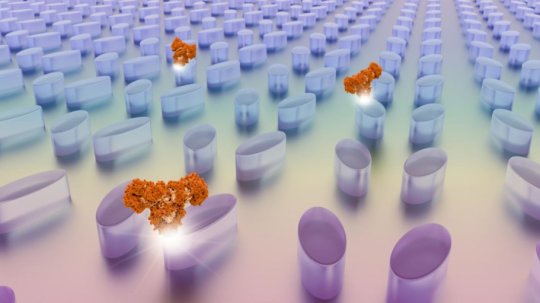[ad_1]
In the not-too-distant future, each of us may have a simple device — small enough for our nightstand or our pocket — that keeps us apprised of our level of health, identifies even trace amounts of undesirable biomarkers in our blood or saliva and serves as an early-warning system for diseases. This is one of the promises of personalized medicine.
This technological revolution may be one step closer thanks to a powerful tool developed by researchers at EPFL’s BioNanoPhotonic Systems (BIOS) Laboratory. It consists of an ultra-thin and miniaturized optical chip that, when coupled with a standard CMOS camera and powered by image analysis, is able to count biomolecules one by one in a sample and determine their location. Their research has been published in Nature Photonics.
A very powerful sensor
This pioneering technology is based on metasurfaces — rising stars in the field of photonics. Metasurfaces are sheets of artificial materials covered in millions of nano-sized elements arranged in a special way. At a certain frequency, these elements are able to squeeze light into extremely small volumes, creating ultrasensitive optical ‘hotspots’.
When light shines on the metasurface and hits a molecule at one of these hotspots, the molecule is detected immediately. In fact, the molecule gives itself away by changing the wavelength of the light that hits it.
Scanning molecules and taking their picture
By using different colored lights on the metasurface and taking a picture each time with a CMOS camera, the researchers are able to count the number of molecules in a sample and learn exactly what is happening on the sensor chip. “We then use smart data science tools to analyze the millions of CMOS pixels obtained through this process and identify trends,” says Filiz Yesilkoy, the article’s first author. “We’ve demonstrated that we can detect and image not just individual biomolecules at the hotspots, but even a single graphene sheet that’s only one atom thick.”
Taking their work one step further, the researchers developed a second version of their system, where the metasurfaces are programmed to resonate at different wavelengths in different regions. “This technique is simpler, yet it is also less precise in locating the molecules,” says Eduardo R. Arvelo, one of the article’s co-authors.
A game changer in disease detection?
Hatice Altug, who runs the BIOS lab and is leading the project, sees immense potential in the field of optics. “Light possesses many attributes — such as intensity, phase and polarization — and is capable of traversing space. This means that optical sensors could play a major role in addressing future challenges — particularly in personalized medicine.”
Story Source:
Materials provided by Ecole Polytechnique Fédérale de Lausanne. Note: Content may be edited for style and length.
[ad_2]















